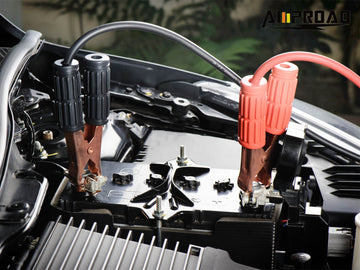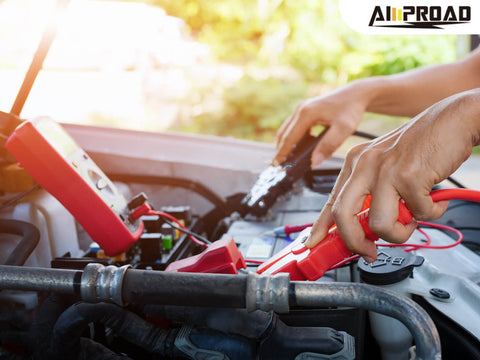
In the age of car troubles, a dead battery can leave you stranded and frustrated. While most people know about using a jump starter (also known as jumper cables) to revive a dead battery, a question often arises: can a diesel car jump start a gas car, and vice versa? The answer, like many things in life, is a nuanced "it depends." This article delves into the world of jump starting, exploring the compatibility between diesel and gas car batteries, safety considerations, and the proper jump-starting procedure.
Understanding Battery Basics: Voltage Matters
At the heart of the compatibility question lies the concept of battery voltage. Most car batteries, regardless of gasoline or diesel engines, operate on a 12-volt system. This means both battery types have the same nominal voltage output, making them theoretically compatible for jump starting in an emergency.
However, there are some key differences between gas and diesel car batteries:
Cold Cranking Amps (CCA): This rating indicates a battery's ability to deliver a burst of current during engine startup, especially in cold weather. Diesel engines generally require a higher CCA rating due to their higher compression ratios.
Reserve Capacity (RC): This rating represents the battery's ability to sustain electrical power over time, such as running lights and powering onboard electronics while the engine is off. Gas car batteries typically have a higher RC compared to diesel batteries.
The Green Light: When a Diesel Can Jump Start a Gas Car
Here's when using a diesel car to jump start a gas car is generally considered safe:
Matching Voltage: As mentioned earlier, both battery types operate on a 12-volt system, ensuring compatibility.
Sufficient CCA: If the diesel car battery has a CCA rating equal to or higher than the gas car battery, it can provide the necessary cranking power to start the gas engine.
Healthy Diesel Battery: The diesel car's battery should be in good health and fully charged to effectively jump start the gas car.
Example: Imagine a gas car with a dead battery rated at 400 CCA. If a diesel car has a healthy battery rated at 600 CCA, it can safely provide the necessary cranking power to jump start the gas car.
Proceed with Caution: When Compatibility Gets Tricky

While a diesel jump start for a gas car can work under certain conditions, there are situations where caution is advised:
Lower CCA in Diesel Battery: If the diesel car's battery has a lower CCA rating than the gas car battery, it might not deliver enough cranking power to start the gas engine. This could lead to repeated unsuccessful attempts and potentially damage the electronics in either car.
Uncertain Battery Health: If you're unsure about the health of the diesel car's battery, it's best to err on the side of caution and seek alternative assistance. A weak or failing battery might not provide the necessary boost and could further drain its own charge.
Newer Vehicles with Advanced Electronics: Consult your owner's manuals for both vehicles. Some newer cars with sophisticated electronics might have specific recommendations regarding jump starting procedures or compatibility with different battery types.
The Golden Rule: When in doubt, it's always better to contact a professional roadside assistance service or a qualified mechanic for a safe and reliable battery boost.
A Step-by-Step Guide Jump Starting
If you're confident about the compatibility and health of both batteries, here's a safe and effective way to jump start a gas car using a diesel car:
Park the Vehicles: Position the vehicles close enough for the jumper cables to reach both batteries comfortably but not touching each other. Ensure both cars are turned off and parked in Park (automatic) or Neutral (manual).
Prepare the Jumper Cables: Unfold the jumper cables and identify the positive (red) and negative (black) clamps.
Connect Positive Terminals: Carefully connect the positive (red) clamp of one jumper cable to the positive terminal of the dead gas car battery. Then, connect the other positive (red) clamp to the positive terminal of the healthy diesel car battery.
Connect Negative Terminals: Locate the negative terminal (usually black) on the gas car battery, ensuring it's away from the battery itself (often on a nearby metal body point). Now, connect the negative (black) clamp of the other jumper cable to this negative terminal on the gas car battery. Finally, connect the remaining negative (black) clamp to the negative terminal of the diesel car battery.
Start the Diesel Car: Start the diesel car and let it run for a few minutes to allow its alternator to replenish.
Start the Gas Car: After a few minutes, attempt to start the gas car. If it cranks but doesn't start immediately, give it a few more seconds before trying again. Avoid cranking for extended periods to prevent overheating the starter motor.
Disconnect Cables in Reverse Order: Once the gas car starts successfully, it's crucial to disconnect the jumper cables in the reverse order they were connected. This helps prevent sparks that could ignite flammable materials around the battery. Here's the order for disconnecting:
- Negative clamp on the diesel car
- Negative clamp on the gas car (away from the battery first)
- Positive clamp on the diesel car
- Positive clamp on the gas car
Let the Gas Car Run: Allow the gas car to run for at least 15-20 minutes to recharge its own battery through the alternator. This will help prevent another immediate stall.
Important Safety Precautions
- Never touch the positive and negative clamps together while the cables are connected to the batteries.This can cause sparks and potential damage.
- Do not attempt to jump start a frozen engine.The extreme cold can further complicate the situation.
- If the gas car fails to start after multiple attempts, there might be a more serious underlying issue.It's best to call for professional assistance.
Understanding Diesel and Gas Car Battery Differences

To fully grasp the nuances of jump starting between diesel and gas cars, it’s essential to delve deeper into the differences in their battery requirements and functionalities.
Diesel Car Batteries:
Diesel engines require more power to start because of their higher compression ratios. This need is reflected in the higher CCA ratings typically found in diesel car batteries. The CCA rating measures a battery’s ability to start an engine in cold temperatures, which is crucial for diesel vehicles, especially in colder climates.
Gas Car Batteries:
Gasoline engines generally have lower compression ratios compared to diesel engines, meaning they require less power to start. This is why gas car batteries usually have lower CCA ratings but higher reserve capacities (RC). The RC rating indicates how long a battery can power a vehicle's electrical systems if the alternator fails, which is particularly useful for gas cars with many electronic accessories.
Potential Risks and Challenges
While jump starting a gas car with a diesel car can be straightforward, there are potential risks and challenges to be aware of:
Battery Health and Age: The age and health of the batteries in both vehicles can significantly impact the success of a jump start. Older or poorly maintained batteries might not hold a charge well or provide adequate power for the task.
Electronic System Sensitivity: Modern vehicles, particularly those with advanced electronic systems, may be sensitive to power surges during jump starting. This sensitivity means there is a risk of damaging delicate electronic components if the process is not handled correctly.
Alternator Strain: Continuously using a diesel car to jump start other vehicles can put additional strain on its alternator. Over time, this strain can lead to premature alternator failure, which is an expensive repair.
Professional Assistance and Alternatives
While knowing how to boost a car is valuable, sometimes professional assistance is the best course of action. Roadside assistance services are equipped with the proper tools and expertise to handle such situations safely and efficiently. Moreover, these services can diagnose if a jump start is not the appropriate solution, potentially saving you from further complications.
Portable Jump Starters: Another alternative is to carry a portable jump starter. These devices like AMPROAD iRock40 jump starter, are compact, easy to use, and capable of jump starting a vehicle without needing another car. Investing in a quality portable battery booster can be a lifesaver, providing peace of mind and convenience.
Preventative Measures
To minimize the chances of encountering a dead battery, consider these preventative measures:
Regular Maintenance: Regularly check your battery’s health, clean the terminals, and ensure it is securely mounted. Testing your battery's charge at regular intervals can preemptively highlight any potential issues.
Battery Replacement: Replace your battery as recommended by the manufacturer, typically every 3-5 years. Proactively replacing an aging battery can prevent sudden failures.
Avoiding Short Trips: Short trips do not give the alternator enough time to recharge the battery fully. Combine short trips into longer journeys when possible to keep your battery charged.
Turning Off Electronics: Ensure all lights and electronic accessories are turned off when the vehicle is not in use. Leaving these on can drain the battery quickly, especially in older vehicles without automatic shut-off features.
Jump-Starting Success
By following these guidelines and understanding the compatibility factors, you can safely jump start a gas car using a diesel car in an emergency. Remember, prevention is always better than cure. Regularly maintaining your car battery and ensuring it's in good health can significantly reduce the chances of encountering a dead battery situation.
All in all, while it is possible for a diesel car to jump start a gas car and vice versa, there are several considerations and precautions to take into account. Understanding the differences in battery requirements, adhering to the proper jump-starting procedure, and prioritizing safety are crucial. By staying informed and prepared, you can navigate these situations effectively and keep your vehicle running smoothly.


